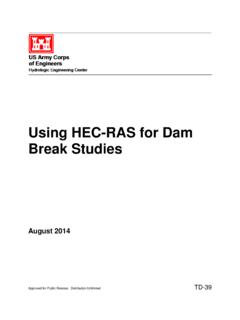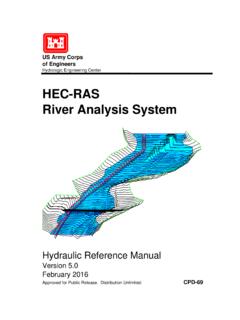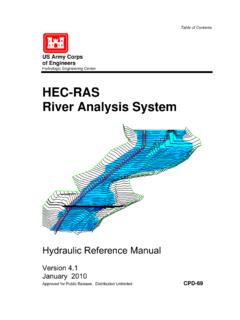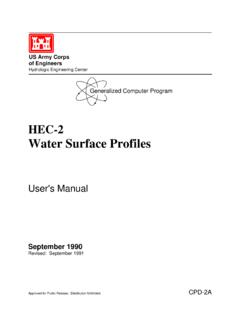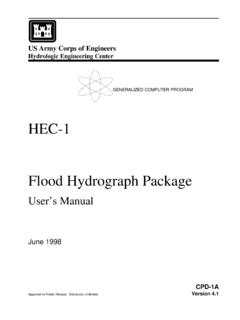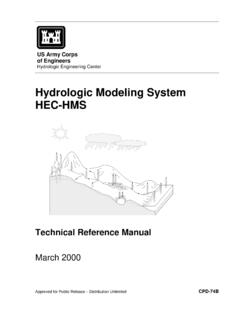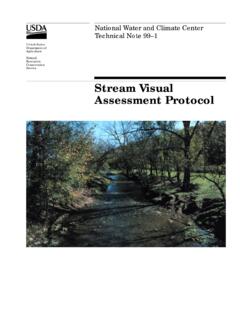Transcription of HEC-RAS River Analysis System
1 Table of Contents US Army Corps of Engineers Hydrologic Engineering Center HEC-RAS River Analysis System Hydraulic Reference Manual Version January 2010 Approved for Public Release. Distribution Unlimited CPD-69 REPORT DOCUMENTATION PAGE Form Approved OMB No. 0704-0188 Public reporting burden for this collection of information is estimated to average 1 hour per response, including the time for reviewing instructions, searching existing data sources, gathering and maintaining the date needed, and completing and reviewing the collection of information. Send comments regarding this burden estimate or any other aspect of this collection of information, including suggestions for reducing this burden, to Washington Headquarters Services, Directorate for Information Operations and Reports, 1215 Jefferson Davis Highway, Suite 1204, Arlington, VA 22202-4302, and to the Office of Management and Budget, Paperwork Reduction Project (0704-0188), Washington, DC 20503.
2 1. AGENCY USE ONLY (Leave blank) 2. REPORT DATE January, 2010 3. REPORT TYPE AND DATES COVERED Computer Program Documentation 4. TITLE AND SUBTITLE HEC-RAS , River Analysis System Hydraulic Reference Manual 5. FUNDING NUMBERS 6. AUTHOR(S) Gary W. Brunner 7. PERFORMING ORGANIZATION NAME(S) AND ADDRESS(ES) US ARMY CORPS OF ENGINEERS HYDROLOGIC ENGINEERING CENTER (HEC) 609 Second Street Davis, CA 95616-4687 8. PERFORMING ORGANIZATION REPORT NUMBER CPD-69 9. SPONSORING / MONITORING AGENCY NAME(S) AND ADDRESS(ES) 10. SPONSORING / MONITORING AGENCY REPORT NUMBER 11. SUPPLEMENTARY NOTES 12a. DISTRIBUTION / AVAILABILITY STATEMENT Approved for Public Release. Distribution is unlimited. 12b. DISTRIBUTION CODE 13. ABSTRACT (Maximum 200 words) The Army Corps of Engineers River Analysis System ( HEC-RAS ) is software that allows you to perform one-dimensional steady and unsteady flow River hydraulics calculations.
3 HEC-RAS is an integrated System of software, designed for interactive use in a multi-tasking, multi-user network environment. The System is comprised of a graphical user interface (GUI), separate hydraulic Analysis components, data storage and management capabilities, graphics and reporting facilities. The HEC-RAS System will ultimately contain three one-dimensional hydraulic Analysis components for: (1) steady flow water surface profile computations; (2) unsteady flow simulation; and (3) movable boundary sediment transport computations. A key element is that all three components will use a common geometric data representation and common geometric and hydraulic computation routines. In addition to the three hydraulic Analysis components, the System contains several hydraulic design features that can be invoked once the basic water surface profiles are computed.
4 The current version of HEC-RAS supports Steady and Unsteady flow water surface profile calculations. New features and additional capabilities will be added in future releases. 14. SUBJECT TERMS water surface profiles, River hydraulics, steady and unsteady flow, computer program 15. NUMBER OF PAGES 411 16. PRICE CODE 17. SECURITY CLASSIFICATION OF REPORT UNCLASSIFIED 18. SECURITY CLASSIFICATION OF THIS PAGE UNCLASSIFIED 19. SECURITY CLASSIFICATION OF ABSTRACT UNCLASSIFIED 20. LIMITATION OF ABSTRACT UNLIMITED Table of Contents HEC-RAS River Analysis System Hydraulic Reference Manual Version January 2010 Army Corps of Engineers Institute For Water Resources Hydrologic Engineering Center 609 Second Street Davis, CA 95616 (530) 756-1104 (530) 756-8250 FAX iii iv Table of Contents Table of Contents Table of Contents.
5 V CHAPTER 1 .. 1-1 Introduction .. 1-1 1-1 General Philosophy of the Modeling System ..1-2 Overview of Hydraulic Capabilities .. 1-2 HEC-RAS Documentation .. 1-4 Overview of This 1-4 CHAPTER 2 .. 2-1 Theoretical Basis for One-Dimensional Flow Calculations .. 2-1 2-1 General .. 2-2 Steady Flow Water Surface 2-2 Equations for Basic Profile Calculations .. 2-2 Cross Section Subdivision for Conveyance 2-4 Composite Manning's n for the Main Channel .. 2-6 Evaluation of the Mean Kinetic Energy Head .. 2-8 Friction Loss 2-9 Contraction and Expansion Loss Evaluation .. 2-10 Computation Procedure .. 2-11 Critical Depth Determination .. 2-13 Applications of the Momentum Equation .. 2-16 Air Entrainment in High Velocity Streams .. 2-19 Steady Flow Program Limitations ..2-20 Unsteady Flow 2-22 Continuity Equation .. 2-22 Momentum Equation .. 2-23 Application of the Unsteady Flow Equations Within HEC-RAS .
6 2-28 Implicit Finite Difference Scheme .. 2-30 Continuity Equation .. 2-32 Momentum Equation .. 2-33 Added Force 2-35 Lateral Influx of Momentum .. 2-36 Finite Difference Form of the Unsteady Flow 2-37 Linearized, Implicit, Finite Difference Equations .. 2-37 Finite Difference Approximation .. 2-39 Flow Distribution 2-42 Equivalent Flow Path .. 2-42 Boundary 2-43 Interior Boundary Conditions (for Reach Connections).. 2-43 Upstream Boundary Conditions ..2-44 Downstream Boundary Conditions .. 2-45 Skyline Solution of a Sparse System of Linear Equations .. 2-47 CHAPTER 3 .. 3-1 Basic Data Requirements .. 3-1 3-1 General .. 3-2 Geometric Data .. 3-2 Study Limit 3-2 The River System 3-3 v Table of Contents Cross Section Geometry .. 3-5 Optional Cross Section Properties .. 3-8 Reach Lengths .. 3-12 Energy Loss 3-12 Stream Junction Data .. 3-22 Steady Flow 3-23 Flow 3-23 Boundary Conditions.
7 3-23 Discharge Information .. 3-25 Unsteady Flow Data .. 3-25 Boundary Conditions .. 3-25 Initial Conditions .. 3-25 CHAPTER 4 .. 4-1 Overview of Optional Capabilities .. 4-1 Contents .. 4-1 Multiple Profile 4-2 Multiple Plan Analysis .. 4-2 Optional Friction Loss Equations .. 4-2 Cross Section 4-4 Mixed Flow Regime Calculations .. 4-6 Modeling Stream Junctions .. 4-9 Energy Based Junction Method .. 4-9 Momentum Based Junction Method .. 4-15 Flow Distribution Calculations .. 4-19 Split Flow Optimization .. 4-22 Pressurized Pipe 4-23 Estimating Ungaged Area 4-30 4-30 Optimization of Ungaged Inflow .. 4-32 Simultaneous Optimization of Independent 4-33 Sequential Optimization .. 4-33 CHAPTER 5 .. 5-1 Modeling 5-1 Contents .. 5-1 General Modeling Guidelines .. 5-2 Cross Section Locations .. 5-2 Defining Ineffective Flow Areas .. 5-5 Contraction and Expansion Losses.
8 5-8 Hydraulic Computations Through the Low Flow Computations .. 5-9 High Flow 5-18 Combination Flow .. 5-25 Selecting a Bridge Modeling 5-26 Low Flow 5-26 High Flow Methods .. 5-27 Unique Bridge Problems and Suggested 5-28 Perched Bridges .. 5-28 Low Water 5-29 Bridges on a Skew .. 5-30 Parallel 5-31 Multiple Bridge Opening .. 5-32 Modeling Floating Pier Debris .. 5-33 CHAPTER 6 .. 6-36 Modeling 6-36 Contents .. 6-36 General Modeling Guidelines .. 6-2 vi Table of Contents Types of Culverts .. 6-2 Cross Section Locations .. 6-3 Expansion and Contraction Coefficients ..6-7 Limitations of the Culvert Routines in HEC-RAS .. 6-7 Culvert Hydraulics .. 6-7 Introduction to Culvert Terminology .. 6-7 Flow Analysis for 6-9 Computing Inlet Control Headwater .. 6-11 Computing Outlet Control 6-12 FHWA Full Flow 6-14 Direct Step Water Surface Profile Computations.
9 6-15 Normal Depth of Flow in the Critical Depth of Flow in the Culvert .. 6-16 Horizontal and Adverse Culvert Slopes .. 6-17 Weir 6-17 Supercritical and Mixed Flow Regime Inside of Culvert .. 6-18 Multiple Manning s n Values Inside of 6-18 Partially Filled or Buried 6-19 Culvert Data and Coefficients .. 6-20 Culvert Shape and 6-20 Culvert 6-22 Number of Identical Barrels .. 6-22 Manning's Roughness Coefficient ..6-22 Entrance Loss Coefficient .. 6-23 Exit Loss 6-27 FHWA Chart and Scale Numbers .. 6-28 Culvert Invert 6-34 Weir Flow 6-35 CHAPTER 7 .. 7-1 Modeling Multiple Bridge and/or Culvert Openings .. 7-1 7-1 General Modeling 7-2 Multiple Opening 7-2 Locating the Stagnation Points .. 7-4 Computational Procedure for Multiple 7-5 Limitations of the Multiple Opening Approach .. 7-7 Divided Flow Approach .. 7-7 CHAPTER 8 .. 8-1 Modeling Gated Spillways, Weirs and Drop Structures.
10 8-1 8-1 General Modeling 8-2 Cross Section Locations .. 8-3 Expansion and Contraction Coefficients ..8-7 Hydraulic Computations Through Gated 8-7 Radial Gates .. 8-8 Sluice Gate .. 8-9 Overflow 8-10 Low Flow Through The Gates ..8-11 Uncontrolled Overflow Weirs .. 8-13 Modeling Lateral Structures .. 8-15 Hager s Lateral Weir 8-17 Drop Structures .. 8-19 CHAPTER 9 .. 9-1 Floodplain Encroachment Calculations .. 9-1 9-1 Introduction .. 9-2 vii Table of Contents Encroachment Methods .. 9-2 Encroachment Method 9-2 Encroachment Method 9-3 Encroachment Method 9-4 Encroachment Method 9-5 Encroachment Method 9-6 Bridge, Culvert, and Multiple Opening Encroachments .. 9-7 General Modeling Guidelines .. 9-8 CHAPTER 10 .. 10-1 Estimating Scour at Bridges .. 10-1 Contents .. 10-1 General Modeling Guidelines .. 10-2 Computing Contraction Scour.
